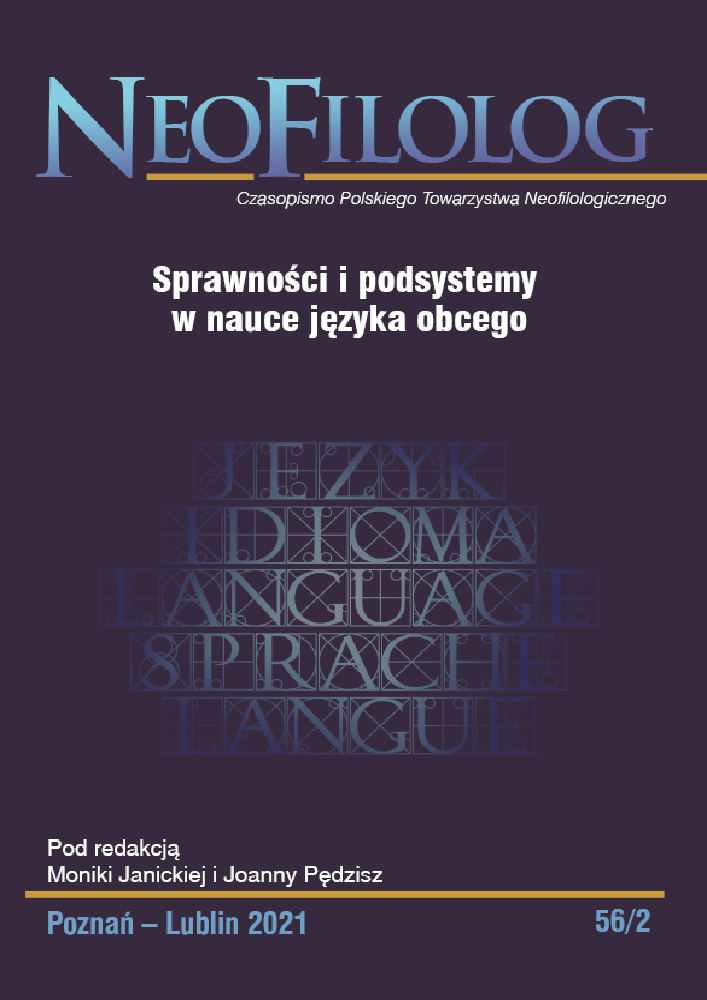Abstrakt
The present study aims to investigate the use of Polish and Czech as a lingua receptiva (LaRa) in comparison with English as a lingua franca (ELF) between Polish and Czech students when making semi-spontaneous dialogues. With this aim in mind, the notion of intelligibility together with communication strategies (CSs) and intercultural communicative competence (ICC) are discussed. The study is inspired by Bulatović’s et al. (2019) who investigated the effectiveness of LaRa and ELF between Croatians and Slovenes. The study investigated listening skills and showed that the mean of intelligibility was high irrespective of the mode. The study in question aims to expand prior research with reference to spoken interactions between Polish and Czech speakers. In particular, it examines the role of communication strategies and intercultural communicative competence in achieving intelligibility in two multilingual modes. The results of the study show that the level of intelligibility is high irrespective of the mode. In LaRa and ELF sessions intelligibility and negotiation strategies are determined by careful language choices, certain communication strategies, and intercultural communicative competence (intercultural attitude towards the partner and modes of communication).
Bibliografia
Bahtina-Jantsikene D. (2013), Mind Your Languages: Lingua Receptiva in Estonian-Russian Communication. Utrecht: Utrecht University Reposi-tory.
Beerkens R. (2010), Receptive Multilingualism as a Language Mode in the Dutch-German Border Area. Münster: Waxmann Verlag GmbH.
Blees G., ten Thije, J. D. (2015), Receptive multilingualism and awareness, (in:) J. Cenoz et al. (eds.), Language Awareness and Multilingualism. Encyclopedia of Language and Education. Switzerland: Springer International Publishing, pp.1–13.
Braunmüller K. (2008), On the Relevance of Receptive Multilingualism in a Globalised World: Theory, History and Evidence from Today’s Scandi-navia. Hamburg: SBF.
Bulatović S., Schüppert A., Gooskens Ch. (2019), Receptive multilingualism versus ELF: How well do Slovenes understand Croatian compared to Croatian speakers’ English? “JELF”, 8 (1), pp. 37–65.
Byram M. (1997), Teaching and assessing intercultural communicative com-petence. Clevedon, UK: Multilingual Matters.
Canale M., Swain M. (1980), Theoretical bases of communicative approaches to second language teaching and testing. “Applied Linguistics”,1, pp. 1–47.
Færch C., Kasper G. (1984), Two ways of defining communication strategies. “Lan-guage Learning. A Journal of Research in Language Studies”, 34 (1), pp. 45–63.
Golubović J. (2016), Mutual intelligibility in the Slavic language area. Gronin-gen. University of Groningen.
Gooskens Ch., van Heuven V.J., Golubović J., Schüppert A., Swarte F., Voigt S. (2017), Mutual intelligibility between closely related languages in Europe. “International Journal of Multilingualism”, 15 (2), pp. 1–25.
Haugen E. (1966), Semicommunication: the language gap in Scandinavia. “Sociological Inquiry”, 36 (2), pp. 280–297.
Hua T.K., Nor N.F.M., Jaradat M.N. (2012), Communication Strategies Among EFL Students - An Examination Of Frequency Of Use And Types Of Strategies Used. “GEMA Online™ Journal of Language Studies”, 12 (3), pp. 831–848.
Hülmbauer C., Böhringer H., Seidlhofer B. (2008), Introducing English as a lingua franca (ELF): Precursor and partner in intercultural communi-cation. “Synergies. Europe”, 3, pp. 25–36.
Hülmbauer C. (2014), A matter of reception: ELF and LaRa compared. “Ap-plied Linguistics Review”, 5 (1), pp. 273–295.
Jenkins J. (2009), English as a Lingua Franca: interpretations and attitudes. “World Englishes”, 28 (2), pp. 200–207.
Jenkins J. (2011), Accommodating (to) ELF in the international university. “Journal of Pragmatics”, 43 (4), pp. 926–936.
Krysztofowicz D. (2017), Lingua receptiva – pojęcie oraz perspektywy dla komunikacji interkulturowej (in.) V. Kamas et al. (eds.), Język w Poznaniu 7. Poznań: Wydawnictwo Rys, pp. 89–98.
Mariani L. (2010), Communication strategies – Learning and teaching how to manage oral interaction. Italy: Learning Paths.
Marx N. (2012), Reading across the Germanic languages: Is equal access just wishful thinking? “International Journal of Bilingualism”, 16 (4), pp. 463–483.
Rehbein J., ten Thije J. D., Verschik A. (2012), Lingua receptiva (LaRa) – re-marks on the quintessence of receptive multilingualism. “International Journal of Bilingualism”, 16 (3), pp. 248–264.
Seidlhofer, B. (2011), Understanding English as a lingua franca. Oxford: Ox-ford University Press.
Sloboda M., Nábělková M. (2013), Receptive multilingualism in ‘monolingual’ media: managing the presence of Slovak on Czech websites. “International Journal of Multilingualism”, 10 (2), pp. 196–213.
Steciąg M. (2019), “What is the best language for Eastern Europe?” Lingua receptiva as a new approach in Slavic intercommunication research. “Slavia Centralis”, 2, pp. 85– 95.
Steciąg M. (2020), Lingua Receptiva: the Map and the Territory. “Przegląd Wschodnioeuropejski”, XI (2), pp. 487–497.
ten Thije J. D. (2014), The effectiveness of Lingua Receptiva (LaRa) in multilingual communication – Editorial. “Applied Linguistics Review”, 5 (1), pp. 125–129.
ten Thije J. D., Gooskens Ch., Daems F., Cornips L., Smits M., (2017), Lingua Receptiva. Position paper on the European Commission’s Skills Agenda. “European Journal of Applied Linguistics”, 5 (1), pp. 141–146.
Tarone E. (1981), Some Thoughts on the Notion of Communication Strategy. “TESOL Quarterly”, 15 (3), pp. 285–295.
Voegelin Ch. F., Harris Z. S. (1951), Methods for determining intelligibility among dialects of national languages. “Proceedings of the American Philosophical Society”, 95 (3), pp. 322– 329.
Willems G. M. (1987), Communication strategies and their significance in foreign language teaching. “System”, 15 (3), pp. 351–364.
NETOGRAPHY:
Bulatović S. (2014), Lingua franca vs. lingua receptiva. Does English always work better? retrieved from: https://www.semanticscholar.org/paper/LINGUA-FRANCA-VS-.-LINGUA-RECEPTIVA-%3A-DOES-ENGLISH-Bulatovi%C4%87/bfe024bc5078c48666675c4d2c00bf4e71cf01f4 [Accessed on 19.12.2019]
Council Resolution of 21 November 2008 on a European strategy for multilingualism c_32020081216en00010003.pdf (europa.eu) [Accessed on 12.02.2021]
Informatory – CKE: język angielski [Accessed on 12.02.2021]
LARA course (Utrecht University) https://students.uu.nl/en/hum/lingua-receptiva [Accessed on 19.03.2020]
MICRela: http://www.let.rug.nl/gooskens/project/?p=home [Accessed on 12.02.2021]
New Matura Success Pre-Intermediate (Pearson) http://pm.malopolska.pl/joomla/pliki/1112/zestawy_maturalne_success_pre-inter.pdf [Accessed on 11.11.2019]
Official site of the research project: https://ecolapra.eu [Accessed on 14.06.2020]
Licencja
Prawa autorskie (c) 2021 Magdalena Steciąg, Urszula Majdańska-Wachowicz

Utwór dostępny jest na licencji Creative Commons Uznanie autorstwa – Bez utworów zależnych 4.0 Międzynarodowe.
Przedstawiany utwór (artykuł) upubliczniany jest na podstawie umowy z autorem i na licencji Creative Commons Attribution-NoDerivatives 4.0 International (CC BY-ND 4.0).
Użytkownicy mają obowiązek podania wraz z rozpowszechnionym utworem, informacji o autorstwie, tytule, źródle (odnośniki do oryginalnego utworu, DOI) oraz samej licencji;
- bez tworzenia utworów zależnych,
- utwór musi być zachowany w oryginalnej postaci.
Uniwersytet im. Adama Mickiewicza w Poznaniu zachowuje prawo do czasopisma jako całości (układ, forma graficzna, tytuł, projekt okładki, logo itp.).

